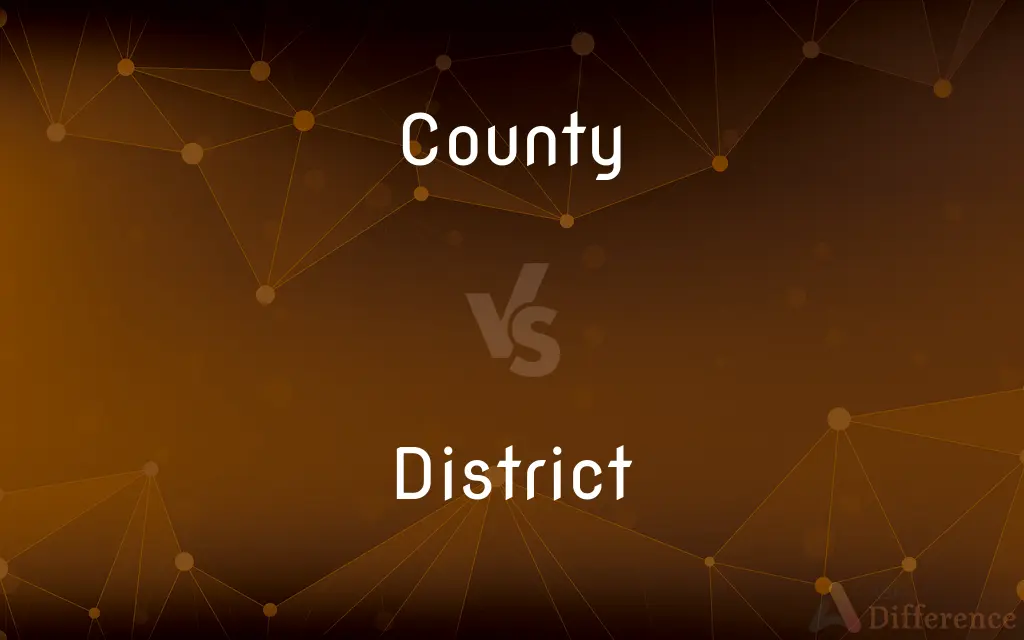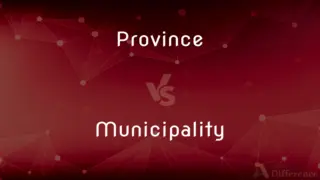County vs. District — What's the Difference?
By Fiza Rafique & Urooj Arif — Updated on March 6, 2024
A county is an administrative division within a state or country, focusing on local governance. A district, however, often refers to any administrative, electoral, or educational subdivision.

Difference Between County and District
Table of Contents
ADVERTISEMENT
Key Differences
A county is typically a larger administrative division within a state or country, tasked with local governance, law enforcement, and public services. Counties often have their own elected officials, such as sheriffs and commissioners, and are responsible for areas like public health, safety, and infrastructure. Districts, on the other hand, are subdivisions that can exist within countries, states, or counties, and their functions and importance vary widely by context. In some countries, districts are primarily used for electoral purposes, defining areas from which representatives are elected.
In the United States, for example, counties are key governmental entities, whereas in the UK, they serve more as ceremonial regions with varying degrees of administrative authority. In others, districts might be administrative divisions within a city or county, managing local issues such as education, with school districts being a common example in the United States.
One significant difference lies in the level of autonomy and the range of services provided. Counties often have broader powers and responsibilities, including maintaining roads, providing law enforcement, and managing public records. Districts, depending on their nature, might have more focused duties, such as overseeing schools or managing water resources.
The geographical size and population covered by counties and districts can also vary greatly. Counties typically cover larger areas and encompass multiple towns or cities, whereas districts could be as large as a county or as small as a part of a city, depending on the country and the specific purpose of the district.
The governance structure of counties and districts also differs. Counties usually have elected officials and a structured government, while districts may be governed by appointed officials or boards, especially in the case of specialized districts like school or water districts.
ADVERTISEMENT
Comparison Chart
Definition
An administrative division within a state or country.
A subdivision used for administrative, electoral, or educational purposes.
Governance
Typically governed by elected officials (e.g., sheriffs, commissioners).
Governance can vary; may be overseen by appointed officials or boards.
Functions
Broad responsibilities including law enforcement, public health, and infrastructure.
Functions vary widely; can be focused on specific areas like education or water management.
Geographical Size
Generally covers larger areas, encompassing multiple towns or cities.
Size varies; can range from part of a city to as large as a county.
Autonomy
Often has significant autonomy within the legal framework of the state or country.
The level of autonomy can vary significantly depending on the type of district and its governing laws.
Compare with Definitions
County
An administrative division within a country or state, tasked with local governance.
The county sheriff is responsible for law enforcement in unincorporated areas.
District
A geographical area under the jurisdiction of a particular government entity.
The district attorney prosecutes crimes within his jurisdiction.
County
A region distinguished by specific characteristics, often historical or geographical.
This county is known for its vineyards.
District
A sector designated for a specific purpose, such as education or water management.
The water district issued restrictions due to the drought.
County
In some countries, a ceremonial term without significant administrative power.
He was appointed Lord Lieutenant of the county.
District
In urban planning, a zone with particular characteristics or functions.
The historic district is protected by special regulations.
County
A geographical area governed by a county council, providing public services.
She works for the county's public health department.
District
A subdivision for administrative or political purposes, often within a city, county, or country.
The school district oversees all public schools in the area.
County
A jurisdiction for judicial purposes, having its own court system.
The county court hears both civil and criminal cases.
District
An area defined for electoral purposes, from which representatives are elected.
She announced her candidacy for the congressional district.
County
A county is a geographical region of a country used for administrative or other purposes in certain modern nations. The term is derived from the Old French conté or cunté denoting a jurisdiction under the sovereignty of a count (earl) or a viscount.
District
A district is a type of administrative division that, in some countries, is managed by the local government. Across the world, areas known as "districts" vary greatly in size, spanning regions or counties, several municipalities, subdivisions of municipalities, school district, or political district.
County
The largest administrative division of most states in the United States.
District
A division of an area, as for administrative purposes.
County
An administrative region of various countries, including Bhutan, Canada, China, Croatia, Ireland, Japan, New Zealand, Norway, Poland, Romania, South Korea, Sweden, the United Kingdom, and 48 of the 50 United States (excluding Alaska and Louisiana).
District
A region or locality marked by a distinguishing feature
Went to the lake district for their vacation.
County
A region created by territorial division for the purpose of local government;
The county has a population of 12,345 people
District
To divide into districts or limited portions of territory; as, legislatures district States for the choice of representatives.
County
The largest administrative district within a state;
The county plans to build a new road
District
A region marked off for administrative or other purposes
Common Curiosities
What is a county?
A county is an administrative division within a state or country, responsible for local governance and public services.
Who governs counties and districts?
Counties are usually governed by elected officials, whereas districts may be overseen by appointed officials or boards, depending on their nature.
Are counties and districts found in all countries?
The concept of counties and districts exists in many countries, but their roles and importance can vary greatly.
How does the size of a county compare to a district?
Counties typically cover larger areas and encompass multiple towns or cities, while districts can vary greatly in size.
How are districts used in elections?
Districts can be used to define areas from which representatives are elected to legislative bodies.
What is a district?
A district is a subdivision used for various purposes, including administration, elections, or education, depending on the context.
Are districts always governmental entities?
Most districts have governmental roles, but their specific functions and governance can vary widely.
How do district courts differ from county courts?
District courts can refer to federal or state level courts in some countries, focusing on specific judicial districts, whereas county courts deal with legal matters within their respective counties.
Can a district be part of a county?
Yes, districts can exist within counties, especially in contexts like school districts or municipal districts.
What are the responsibilities of a county?
Counties often handle law enforcement, public health, infrastructure, and other local governance tasks.
What are the functions of a district?
District functions vary widely and can include managing education, electoral processes, or specific resources like water.
Can a city be part of a district?
Yes, cities can be part of districts, especially in administrative or electoral contexts.
What is the role of a county sheriff?
The county sheriff typically oversees law enforcement in unincorporated areas of the county.
Do all counties have the same level of autonomy?
The level of autonomy for counties can vary depending on the country's or state's legal framework.
Can a district have its own government?
Some districts, especially those with specific functions like school districts, have their own governing bodies or boards.
Share Your Discovery

Previous Comparison
Part vs. Portion
Next Comparison
Province vs. MunicipalityAuthor Spotlight
Written by
Fiza RafiqueFiza Rafique is a skilled content writer at AskDifference.com, where she meticulously refines and enhances written pieces. Drawing from her vast editorial expertise, Fiza ensures clarity, accuracy, and precision in every article. Passionate about language, she continually seeks to elevate the quality of content for readers worldwide.
Co-written by
Urooj ArifUrooj is a skilled content writer at Ask Difference, known for her exceptional ability to simplify complex topics into engaging and informative content. With a passion for research and a flair for clear, concise writing, she consistently delivers articles that resonate with our diverse audience.
















































